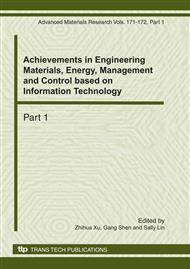p.3
p.7
p.11
p.15
p.19
p.27
p.32
p.36
Adsorptive Removal of Cd(II) by a Novel Extracellular Biopolymer Produced by Pseudomonas alcaligenes: Equilibrium and Kinetics
Abstract:
An extracellular biopolymer (PFC02) produced by Pseudomonas alcaligenes was used as an alternative biosorbent to remove toxic Cd(II) metallic ions from aqueous solutions. The effect of experimental parameters such as pH, Cd(II) initial concentration and contact time on the adsorption was studied. It was found that pH played a major role in the adsorption process, the optimum pH for the removal of Cd(II) was 6.0. The FTIR spectra showed carboxyl, hydroxyl and amino groups of the PFC02 were involved in chemical interaction with the Cd(II) ions. Equilibrium studies showed that Cd(II) adsorption data followed Langmuir model. The maximum adsorption capacity (qmax) for Cd(II) ions was estimated to be 93.55 mg/g. The kinetic studies showed that the kinetic rates were best fitted to the pseudo-second-order model. The study suggestted that the novel extracellular biopolymer biosorbent have potential applications for removing Cd(II) from wastewater.
Info:
Periodical:
Pages:
15-18
Citation:
Online since:
December 2010
Authors:
Price:
Сopyright:
© 2011 Trans Tech Publications Ltd. All Rights Reserved
Share:
Citation:


